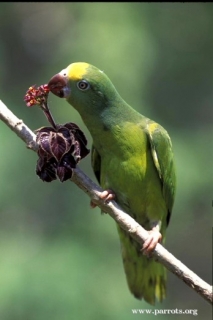Tui Parakeet |
|
|
Also known as: Santarem Parakeet
Photos
View in GalleryDid You Know?
The Tui Parakeet, along with other Brotogeris species, is an arboreal termitarium nester. This means it nests in termite mounds in trees.Academic Research
Related publications: Brotogeris sanctithomaeSpecies Profile
Genus: Brotogeris | Species: sanctithomae
Size:
17cm (6.6 in)
Weight:
58g (2 oz)
Subspecies including nominate:
two: B.s. sanctithomae, B.s. takatsukasae
Colour Adult:
B.s. sanctithomae: Both adults in general yellow/green; yellow forehead, lores and forecrown. Bill dark orange/brown. Eye ring bare and pale grey. Eye yellow.
B.s. takatsukasae: Both adults as in sanctithomae, but with yellow streak behind eye to ear coverts.
Colour Juvenile:
B.s. sanctithomae: As in adults, but with darker brown bill. Eye dark grey.
Call:
Calls made in flight are rapid and repetitious screeking. Chatter of entire flock is reminiscent of Budgerigars.
Listen NowVideo Links:
Video 1More Information:
Content Sources:
CITES
BirdLife International
Cornell Lab of Ornithology/Birds of the World
A Guide to Parrots of the World, Juniper and Parr, 1998
ML Media Collection Catalogue 34272, Tui Parakeet Brotogeris sanctithomae, Parker, Theodore A., III, Loreto, Peru, Jan. 20 1985, Cornell Lab of Ornithology. Site
Parrots of the World, Forshaw and Cooper, 1977. 2010 edition
Lexicon of Parrots, Thomas Arndt.
Parrots of the World, Forshaw, 2006.
Parrots in Aviculture, Low, 1992.
Photos
View in GalleryDid You Know?
The Tui Parakeet, along with other Brotogeris species, is an arboreal termitarium nester. This means it nests in termite mounds in trees.Academic Research
Related publications: Brotogeris sanctithomaeSpecies Care
Captive Status:
Rare.
Longevity:
15 yrs
Housing:
Aviary or suspended enclosure, minimum length 2m (6.5 ft).
Diet:
Fruit such as: apple, pear, banana, pomegranate, cactus fruits, forming about 30 percent of diet; vegetable such as: carrot, celery, green beans, peas in the pod; fresh corn; green leaves such as: Swiss chard, lettuce, sowthistle, dandelion, chickweed; spray millet; small seed mix such as: canary, millet, and smaller amounts of oats, buckwheat, safflower and a little hemp; soaked and sprouted sunflower seed; cooked beans and pulses, boiled maize, and complete kibble.
Enrichment:
Provide water bowls for bathing. Provide foraging/puzzle toys, bird-safe wooden and vegetable tanned leather toys, swings, ladders, ropes, unsprayed branches and perches, and heat sterilized pine cones.
Nest Box Size:
Tree stump or vertical box 8" x 8" x 24" (20.3cm x 20.3cm x 61cm).
Clutch Size:
4-5
Incubation Time:
Probably 24 days.
Fledging Age:
45 days
Hatch Weight:
Not recorded.
Peak Weight:
Not recorded.
Weaning Weight:
Not recorded.
Photos
View in GalleryDid You Know?
The Tui Parakeet, along with other Brotogeris species, is an arboreal termitarium nester. This means it nests in termite mounds in trees.Academic Research
Related publications: Brotogeris sanctithomaeSpecies Wild Status
World Population:
Unknown, decreasing.
IUCN Red List Status:
Least Concern
CITES Listing:
Appendix II
Threat Summary:
Locally abundant with little habitat loss affecting the species in Brazil, and common within the limited range occupied in Colombia, Peru and Bolivia.
Range:
B.s. sanctithomae: Upper Amazon River at Rio Madeira, E Amazonas, N Brazil, west to SE Colombia, NE Peru, and NE Ecuador, and south along Rio Madeira and tributaries to N Bolivia, in Pando and N Beni and SE Peru.
B.s. takatsukasae: N Brazil, along lower Amazon River from Rio Madeira east on north bank to Amapa and on south bank to Rio Curua, E Para.
Habitat:
Found up to 300m (984 ft) in second growth, moist growth lowland tropical rainforest, varzea on banks of larger rivers and river islets, clearings near sources of water.
Wild Diet:
Diet consists of ripe palm fruits and Erythrina fruit, often taking their blossoms; also manioc and sugarcane plantations. Also seen feeding on guaba (Psidium) fruits and Pachyra aquatica and Cecropia sp.
Ecology and Behaviour:
Social, gathering in small flocks or sometimes larger gatherings. Very large flocks seen at food and water sources. Flocks engage in swift, acrobatic flight with frequent changes in direction.
Clutch and Egg Size:
4-5 eggs, 23.0 x 17.0mm (0.9 x 0.7 in).
Breeding Season:
April-July; nests are in termitaria.
Related Links:
Photos
View in GalleryDid You Know?
The Tui Parakeet, along with other Brotogeris species, is an arboreal termitarium nester. This means it nests in termite mounds in trees.Academic Research
Related publications: Brotogeris sanctithomaeMembers Only Resources
Please log-in now to find more research, resources and tools.
Not a Member?
Find more great information:
Gain exclusive access to 600+ pages of additional research, seminars and podcasts, specialists to ask your toughest questions, and dozens of other fun resources - when you become a WPT member.
Join Today >>

































